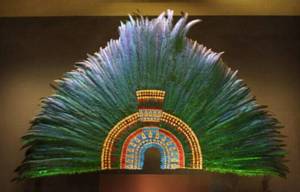
The last Aztec emperor of Mexico, b. 1466, d. c. 30 June 1520 (Tenochtitlán, Mexico).
Montezuma II was the ninth Aztec emperor. When he succeeded his uncle Ahuitzotl as ruler of the Aztecs in 1502 he inherited an empire at the height of its power and territorial extent. From its capital Tenochtitlán Montezuma reigned over the people from today's Honduras to Nicaragua.
The large extent of the empire required significant tribute from its subjugated people, and the Aztec practice of human sacrifice during religious rituals lead to demands to deliver ever more victims. There was thus considerable unrest during Montezuma's reign, and the tribes at some distance from the capital were always inclined to get into alliances with others to escape Aztec rule.
Following the tradition promoted by the astrologer priests of Huitzilopochtli (the sun and war god who had guided the Aztec from their home region Aztlán to the Valley of Mexico) Montezuma undertook a number of military expeditions and conquests. At the same time he and his people were fearful of the predicted arrival of Quetzalcóatl, the white, bearded god who would take over the reign of the empire.
Hernán Cortés, the Spanish conquistador who invaded and took Mexico for the Spanish crown, knew of the Aztec's fear and exploited it during his crossing of Mexico. Montezuma tried to appease him through presents of gold; but this only strengthened Cortés' determination to gain control of the empire. Through alliances with outer tribes he could advance to the capital in 1519. Montezuma invited him into Tenochtitlán; but Cortés recognized the invitation as a trap and arrested him.
Bernal Diaz del Castillio, author of The Conquest of New Spain, described Montezuma II in these words:
When we came near to Mexico, at a place where there where some other small towers, the Great Montezuma descended from his litter, and these other great Caciques supported him beneath a marvellously rich canopy of green feathers, decorated with gold work, silver, pearls, and chalchihuites, which hung from a sort of border. It was a marvellous sight. The Great Montezuma was magnificently clad, in their fashion, and wore sandals of a kind for which their name is cactli, the soles of which are of gold and the upper parts ornamented with precious stones.
And the four other lords who supported him where richly clad also in garments that seemed to have been kept ready for them on the road so that they would accompany their master. For they had not worn clothes like this when they came out to receive us. There were four other great Caciques who carried the canopy above their heads, and many more lords who walked before the great Montezuma, sweeping the ground on which he was to tread, and laying down cloaks so that his feet should not touch the earth. Not one of these chieftains dared to look him in the face. All kept their eyes lowered most reverently except those four lords, his nephews, who were supporting him.
For a while Cortés could keep the Aztecs under control by keeping Montezuma hostage. When the Aztecs tried to assert their independence in 1520 Cortés tried to use Montezuma as a negotiator. But in the eyes of the Aztecs Montezuma had lost his legitimacy as emperor through allowing himself to be held captive, and when he tried to address his people he was attacked with stones and arrows and wounded. He died three days later.
Spanish accounts state that Montezuma died from his wounds. The Aztecs were convinced that he was murdered by his captors. Cortés and his men had to flee the city during the dark of night and were nearly destroyed when they were noticed.
Montezuma's crown, the Kopilli Ketzalli ("precious crown"), was a gold helmet topped with 400 feathers of the sacred Quetzal bird. Cortés had the gold helmet melted down into bars and sent the feathered head piece to Charles V, king of Spain and archduke of Austria, who took it to Austria in 1524. It is now located in the Museum of Ethnology (Völkerkundemuseum) in Vienna.
In 1986, Aztec Indians from Mexico began to gather signatures in the streets of Europe for the return of the Kopilli Ketzalli. They want it displayed in the Anthropological National Museum of Mexico City (Museo Nacional de Antropología) which is built over the remains of Montezuma's residence. The government of Mexico supports their request. Currently, a replica of the head piece is on display in the Anthropological National Museum of Mexico City. This along with other representative items of Mexico's original culture has been offered to the Austrians in exchange for the sacred headdress - so far without success.

Montezuma's crown, the Kopilli Ketzalli
Replica in the Museo Nacional de Antropología, Mexico City;
the original is in the Völkerkundemuseum, Vienna (Hofburg)